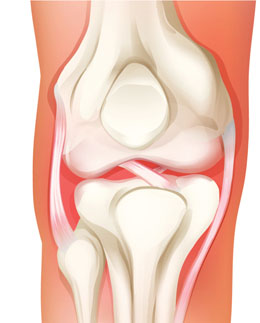Medial collateral ligament or MCL as it is called, is one of the four major ligaments which provide stability to the knee joints. A sprain in this ligament is not very uncommon.

To say that the mechanism of our knees is complex, will be an understatement. It is much more than that. There are 4 crucial ligaments, tendons, and then there are joints. All in all, the knee is a small machine in itself. One of the major ligaments is the medial collateral ligament (MCL). It is one of those ligaments which imparts stability to the knees. The other 3 are lateral collateral ligament, anterior, and posterior cruciate ligament. Any injury to the MCL can lead to impaired knee functioning and movement. Sprain is one of the most common type of injury experienced.
What is MCL?
The MCL is located on the inner side of the knee, and runs from the thigh bone to the shin bone. It resists the pressure applied on the outer surface of the knee. This prevents the medial or the inner portion of the joint from widening. There is one deep inner section of this ligament, and the other is a superficial band which joins higher up on the thigh bone to an area lower on the shin bone's inner part.
Causes of MCL Sprain
MCL sprain can happen on account of a sudden blow or pressure to the outer part of the knee joint. What follows then is impact on the inner or medial part of the knee, leading it to buckle under pressure and widen. If it is an extreme case, the ligament opens up and stretches. It very commonly happens to soccer and hockey players. It culminates in pain, increased sensitivity in the concerned area, bruising, swelling, and inflammation.
Grades of MCL Sprain
There are 3 stages of sprain to this ligament, which in extreme cases, develops into a tear of the ligament.
Grade 1
Here, the ligament is stretched, but the stretch is minor. There is no considerable sprain and strain. The tendon is intact. There is a slight pain as well.
Grade 2
This stage involves a partial tear or sprain to the ligament. A person going through this might experience instability while making a cutting or a pivoting action using their knee. The swelling and bruising is significant in this kind of sprain. There is a restriction on the movement of the knee.
Grade 3
The sprain is acute and chronic in this grade. The ligament is completely torn here, so actually, it is beyond the stage of sprain. There is pain, swelling, and bruising. But the good news is that, it may not be as bad as the grade 2 injury.
Treatment
Treatment depends on what level the injury is. If it is a grade 1 injury, resting, anti-inflammatory medicines, and painkillers and cold compression would do just fine. The recovery time here is a maximum of 2 weeks. A step further into a grade 2 injury leads to use of hinged knee brace, along with the medications. A sabbatical of maximum 4 weeks is necessary for sportsmen, in this case. Physical therapy can further help the patient to recuperate faster, once the initial pain subsides. Physical therapy would involve exercises. However, initially, they would be light, so as not to give an undue stretch to the already damaged ligament.
Now we come to the stage where the ligament is torn. Patients generally wear a knee immobilizer, and take the help of crutches for around 10 days after the injury. Later on, the patient can wear a hinged knee brace. The patient should be able to move his knee for at least 100 degrees before he or she can ride a bike. If this does not seem to work, the last resort would be surgery. But this option is seldom used, and amongst doctors too, there is contention about it.


 To say that the mechanism of our knees is complex, will be an understatement. It is much more than that. There are 4 crucial ligaments, tendons, and then there are joints. All in all, the knee is a small machine in itself. One of the major ligaments is the medial collateral ligament (MCL). It is one of those ligaments which imparts stability to the knees. The other 3 are lateral collateral ligament, anterior, and posterior cruciate ligament. Any injury to the MCL can lead to impaired knee functioning and movement. Sprain is one of the most common type of injury experienced.
To say that the mechanism of our knees is complex, will be an understatement. It is much more than that. There are 4 crucial ligaments, tendons, and then there are joints. All in all, the knee is a small machine in itself. One of the major ligaments is the medial collateral ligament (MCL). It is one of those ligaments which imparts stability to the knees. The other 3 are lateral collateral ligament, anterior, and posterior cruciate ligament. Any injury to the MCL can lead to impaired knee functioning and movement. Sprain is one of the most common type of injury experienced.